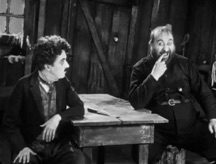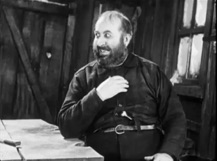The Gold Rush 1923 1925 1926 next previous
The Gold Rush Clippings 141/363
Cal York, Photoplay, New York, February 1925.
The Gold Rush Scenes
& Chaplin Finishing
Latest Picture Sets New Pace for Charlie
By Grace Kingsley
Charlie Chaplin is now in the throes of finishing his latest
reel of „The Gold Rush“ or „The Lucky Strike“
or whatever he decides to name his latest picture, which
has, by the way, been sixteen months in the
making. (...)
Only two weeks more of work remain on the
picture, says Charlie with joy. Some scenes were recently
made on board ship coming from San Diego.
An interesting little incident shows what a wonderful
fellow the comedian is to work with. The incident
was related by Grant Withers, who played the part of the
captain of the boat.
„I got seasick,“ said Withers, „and Charlie took personal
care of me. He got me hot drinks and otherwise
eased my sufferings. When the fellows found out about it they
all began to be seasick, too, and Charlie took care
of two or three of them until he got on.“
(...) FLASHES, Los Angeles Times, April 23, 1925
„The bride wore her traveling costume“
Editorial content. „Charlie‘s Unromantic Marriage
By Cal York
,IT‘S great to be famous, but it‘s sure tough when you
want to pull off a quiet wedding.‘ This must have been Charlie
Chaplin‘s thought after his marriage to little Lita Grey,
his sixteen-year-old leading lady.
There is no doubt that he sought a quiet, unpublicized
wedding, but Charlie learned that no man can
be a public figure, inviting publicity one day, and a recluse
spurning it the next. The public feels that it has bought
and paid for such a figure as Charlie Chaplin and it doesn‘t
make any difference whether he buys a new
automobile, gets a divorce, gets married, or sues“ his
mother-in-law, it wants to know all about it – and
does.“ (...)
„Upon a certain day in November, Charles Spencer
Chaplin, king of comedies and supreme artist
of the screen, was married in the little Mexican town of
Empalme to Lilita Louisa McMurray, professionally
known as Lita Grey.
No exquisite bride in shining satin enters upon this tale.
No candle-lighted drawing room, fragrant with
orange blossoms. No sacred, triumphant music. no brilliant
gathering of celebrated friends to wish the famous
couple joy. No adoring, cheering crowds to scatter blessings
in their path.
Far different.
A dobe hut, with chickens and dogs congregated in the
front yard. A sixteen-year-old girl, in dusty traveling
costume; lawyers, a few Mexicans, a few Japanese servants,
an ex-heavyweight prizefighter, and a dismal dawn
were the principal features at the wedding. Then the bridegroom,
stumbling along railroad ties with his bride behind him,
trying to avoid newspaper men.“ (...)
„ONE day, after the manner of a pale gray fog,
the story began to drift over the Boulevard – the story that
Chaplin had gone to Mexico to marry Lita Grey.
It was denied. But it persisted. Charlie could not be found.
Neither could Lita. They say that Charlie actually
believed he could keep such a world event as his marriage
a real secret.
On October fourteenth, Charlie and Lita went to Empalme
and asked a judge there to marry them. The official
was willing, but Mexican law requires that the intention to wed
be publicly announced thirty days before the ceremony
takes place.
Outside the judge‘s little dobe hut was an old blackboard.
Upon this, therefore, were chalked the names of
Charles Spencer Chaplin and Lilita Louisa McMurray. Below,
as witnesses, Angel Murillo, Jr., Francisco Monge,
Francisco Esqueda and Paul Ramirez.
The party returned to Hollywood.
Thirty days went by – thirty days and a few over. Charlie
was here, there and everywhere. He was more than
usually full of pep. He entertained the Prince and Princess
of Siam. He was master of ceremonies of the opening
of Janice Meredith. He attended dinner parties with this star
and that star, and he gave dinner parties to which
the elite of filmdom were invited.
But nowhere in any of these festivities did anyone
see Lita Grey. Not once did her name appear upon the guest
list.
Soon after the end of the thirty days, Lita and her
mother and her grandmother, once Louisa Carillo and a Spanish
belle of early California, appeared at Guaymas,
accompanied by their lawyer. Lita wore a blue serge middy
and a blue skirt, and looked like any other very young
Mexican girl of the town.
They waited, anxiously, for several days.
Some newspaper correspondents, on trail of the Hollywood
rumor, arrived and she received them.
At two-thirty on the morning of the fourth day, Chaplin‘s
private car arrived. It was dark. The train left it upon
a siding. No signs of life were seen and the little crowd
of newspaper men, met by the ever present
Japanese valet, was told that Mr. Chaplin slept. They went
home.
At four o‘clock, that darkest hour of all, Chaplin got off
the car, accompanied by his Japanese valet, his New
Yorker lawyer, his prizefighter bodyguard, and two personal
friends. He joined his fiance and they began the trip
from Guaymas to Empalme.“ (...)
„Now there is nothing romantic about Empalme.
It exists only because the railroad shops are there.
The population is composed of laborers in the yards. It is drab
and dreary at its best, which is not five o‘clock in
the morning. Packs of Mexican dogs of unidentifiable lineage
scurried from under foot. Roosters crowed disconsolately.
The judge of Empalme who performs wedding
ceremonies, is a very ancient Mexican, over seventy. He speaks
no English, only the poorest Mexican dialect, and
he mumbles that through toothless gums. He has his office
in his house, a tiny dobe hut, and no family can be
expected to have done its housekeeping by five o‘clock
in the morning. So the chamber for the bridal
ceremony was not arrayed even in its poor best.
The wedding party brushed the dust from their clothes
as best they could – Charlie wore the suit which had
served him to travel in from Los Angeles, the bride wore her
traveling costume. They lined up in that drab office
– the great comedian, the sixteen-year-old girl, her mother
and grandmother, the lawyers.
An interpreter translated, so that they did not even
understand the beautiful and sacred words of the Spanish
marriage service.
When it was over, Charlie kissed his wife, and they hurried
to the car.“ (...)
Redaktioneller Inhalt
The Gold Rush 1923 1925 1926 next previous






